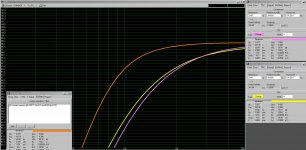Listened Avantgarde Trio here in Hong Kong, at the official distributors place.
My perception was completely different than when i heard it before. This time, the flaws where right away perceivable. Bad integration of the 3 main channels, no much treble extension, and quite colored.
Hi Angelo,
I have spent some time modelling the Avant Garde Trio Horns.
With respect to the lack of treble extension, I think it may be because of the cancellation from the size driver they use for their highs. If you look at their specs, they list a 1" exit driver, but if you model them as exponential horns, the only way that their dimensions for their high frequency horn can expand to 90 degrees at the tangent is by using a 1.4" exit driver, which I believe has some roll-off exhibited above about 12k, which may be what you were experiencing.
i'm a bit scared that beymas will not be able to avoid a ribbon stamp - forensic reproduction devoid of serious dynamic impact of real music - which i dearly hate, if my experience with any ribbon aiming to play under 7-8k so far is relevant. i'm only sensing it needs a driver with very rich tone so some i want to try are vitavox S3 from 450 on, audax PR170M0 from 250 on and fane 8M from 150 on. i will report here on findings..
Gordan
the Beyma has less dynamic contrast than compression drivers. But its still more dynamic than ribbons, sounds fuller, has more " meat ", probably also because it goes lower. That is a tradeoff i am more than happy to accept, to have in the counterpart the tremendous advantages, linearity, homogeneous, very natural and holographic sound. Trying out 8" or 10" direct radiators, i will step into new territory. But i trust the Germans, like Dieter Achenbach, which commercializes a diy kit :
Kits
acording to what i have read on german blogs, the PHL is a perfect match for the Beyma , with very natural and dynamic behavor, and integrating seemlessly.
Hi Angelo,
I have spent some time modelling the Avant Garde Trio Horns.
With respect to the lack of treble extension, I think it may be because of the cancellation from the size driver they use for their highs. If you look at their specs, they list a 1" exit driver, but if you model them as exponential horns, the only way that their dimensions for their high frequency horn can expand to 90 degrees at the tangent is by using a 1.4" exit driver, which I believe has some roll-off exhibited above about 12k, which may be what you were experiencing.
I have made direct comparisons between a 1" compression drivers , Celestion 1425, and Radian 475, in a small round horn with 18cm diameter, JMLC curve, with Coral H100 tweeter, and the difference was clearly perceivable. 1" ers go out of steam earlyer, probably starting at 12khz or so. The Trio was also my starting point when i made my system. You can avoid making basic mistakes, like not time align the drivers, and not arrange them in a vertical line. That will avoid a important part of the weekness of the AV Trio.
I also didnt like the lower midrange of the Trio so much. Mine at home sounds much more natural......to get the timbre and format of instruments rights is not a easy thing. I am still thinking about what is the reason for such a big difference of performance. Many reasons are possible....
Last edited:
I heard Avantgarde Duos and I heard almost all the Wilson line up and can't say I've been impressed with either. I imagine setup was a great deal of both of the issues, but I've heard much better pedestrian systems.
To each their own. I think everyone comes to the table with their own desire/goals and agenda. For me, hi-eff brings something that other speakers don't. I am not married to the Beyma's but I wanted to try them as they are quite different than other approaches.
Josh
To each their own. I think everyone comes to the table with their own desire/goals and agenda. For me, hi-eff brings something that other speakers don't. I am not married to the Beyma's but I wanted to try them as they are quite different than other approaches.
Josh
Mark Levinson stated that the Daniel Hertz M1 uses custom drivers. Attached T/S spreadsheet of high quality production 12" midbass. The M1, similar to the Geddes Summa, decided to create an audio illusion which includes room effects below the horn/baffle polar control frequency.
A 3-way M1-type design (woofer+midbass+CD/Heil) which uses a 12" midbass for high efficiency would have a few design decisions:
1) sealed volume midbass
2) ported/aperodic volume midbass
3) active Xover with equalization
4) passive Xover with port tuning options for passive room bass equalization
5) Low(<0.2) Qts 12" midbass to optimize tweeter sonic interface
6) medium(0.3-0.4) Qts midbass to optimze bass sonic interface
The Qtc=0.15 Beyma 12" midbass is an interesting solution for a large'ish low Qts sealed volume with active Xover that blends well with the CD/HEIL tweeter.(1)+(3)+(5) or (1)+(2aperodic)+(5). The 12P80Nd and 18P80Nd share Beyma's latest motors and cones.
The Qtc=0.29 18Sound 12MBW420 has a very light(33g) cone that makes it a good solution for passive Xovers. (1)+(4)+(6)
An underhung motor with similar T/S specs is possible, and would allow more Mms in the cone material, and waste less Mms in the voice coil.
A 3-way M1-type design (woofer+midbass+CD/Heil) which uses a 12" midbass for high efficiency would have a few design decisions:
1) sealed volume midbass
2) ported/aperodic volume midbass
3) active Xover with equalization
4) passive Xover with port tuning options for passive room bass equalization
5) Low(<0.2) Qts 12" midbass to optimize tweeter sonic interface
6) medium(0.3-0.4) Qts midbass to optimze bass sonic interface
The Qtc=0.15 Beyma 12" midbass is an interesting solution for a large'ish low Qts sealed volume with active Xover that blends well with the CD/HEIL tweeter.(1)+(3)+(5) or (1)+(2aperodic)+(5). The 12P80Nd and 18P80Nd share Beyma's latest motors and cones.
The Qtc=0.29 18Sound 12MBW420 has a very light(33g) cone that makes it a good solution for passive Xovers. (1)+(4)+(6)
An underhung motor with similar T/S specs is possible, and would allow more Mms in the cone material, and waste less Mms in the voice coil.
Attachments
Last edited:
Has anyone tried the Beyma 6G40Fe ?
that seems to be a good contender to pair with TPL in a MTM configuration :
http://profesional.beyma.com/pdf/6G40FeE.pdf
that seems to be a good contender to pair with TPL in a MTM configuration :
http://profesional.beyma.com/pdf/6G40FeE.pdf
Matching sensitivity
Hi Angelo,
I have never tried this driver my self but I have heard an interesting 3 way using it and a the TPL in an active set up....Very nice indeed.
The speakers had 4 of the six inch Beyma drivers ( he was not sure if it was the Neo or Ferrite as he didn't build the speakers) in a mini line array with the TPL mounted to the side, at the mid point of the array.
He said it resulted in 100dB sensitivity of the midranges to match the TPL ( he used the TPL in the horn) and much lower distortion and more natural vocals.
The bass was Beyma 12 inch Pro, not sure which model.
Everything was through an active crossover, not sure what make but he said it was a good studio grade Pro unit. It was all fully balanced, DAC's power amps and crossover.
Lovely clear sound, very natural vocals and cymbals were realistic with both decay and attack.
Cabinets were some sort of nylon sheeting, about 20mm thick and very heavy, CNC'd baffle looked cool in Aqua blue!
Apparently it was built as a PA but sounded so good it ended up in a studio and then bought by a client.
Hope that helps
Derek.
Hi Angelo,
I have never tried this driver my self but I have heard an interesting 3 way using it and a the TPL in an active set up....Very nice indeed.
The speakers had 4 of the six inch Beyma drivers ( he was not sure if it was the Neo or Ferrite as he didn't build the speakers) in a mini line array with the TPL mounted to the side, at the mid point of the array.
He said it resulted in 100dB sensitivity of the midranges to match the TPL ( he used the TPL in the horn) and much lower distortion and more natural vocals.
The bass was Beyma 12 inch Pro, not sure which model.
Everything was through an active crossover, not sure what make but he said it was a good studio grade Pro unit. It was all fully balanced, DAC's power amps and crossover.
Lovely clear sound, very natural vocals and cymbals were realistic with both decay and attack.
Cabinets were some sort of nylon sheeting, about 20mm thick and very heavy, CNC'd baffle looked cool in Aqua blue!
Apparently it was built as a PA but sounded so good it ended up in a studio and then bought by a client.
Hope that helps
Derek.
I have built an OB with TPL 150 , Beyma 10Mi100 mid, Eminence Deltalite 215II woofer.
OB is 55x110 cm laminated baltic birch 36 mm mid and Tw 10 cm offset to center woofer.
Crossover: 10Mi100 to TPL 150 2nd order at 2000Hz passive
Deltalite actively driven by a Crown XLS1000 with 160Hz low pass, equalized with Bheringer ultra curve pro 2496.
TPL 150 is (imho) an extraordinary driver and this very simple setup is sounding to my ears very very good.
Ciao
Bruno
OB is 55x110 cm laminated baltic birch 36 mm mid and Tw 10 cm offset to center woofer.
Crossover: 10Mi100 to TPL 150 2nd order at 2000Hz passive
Deltalite actively driven by a Crown XLS1000 with 160Hz low pass, equalized with Bheringer ultra curve pro 2496.
TPL 150 is (imho) an extraordinary driver and this very simple setup is sounding to my ears very very good.
Ciao
Bruno
Last week i introduced my Hiraga Le Classe A into my system. Together with my dad's speaker cable's sound now is very satisfying. Treble is smooth, no harshness anymore as with Classé DR3b, and Silver speaker cables. I do not see much more improvement possible. On the one side, that is of course very satisfying. On the other side, i do not want to get bored ......
So : two weeks ago i attended a High-end Audio Show in São Paulo. Spoke to some expositors, showed my designs, and they liked them very much. So i am encouraged maibe to make something commercial. Most of the exposed speakers were rather small size, to fit small living rooms.
So i am designing a speaker system, which should attend following criteria :
be small, not too expensive, but still with excellent sonic performance, and nice lookings.
The Beyma TPL is expensive. I found following alternative :
AMT : YDG718-01-4Ω-50W
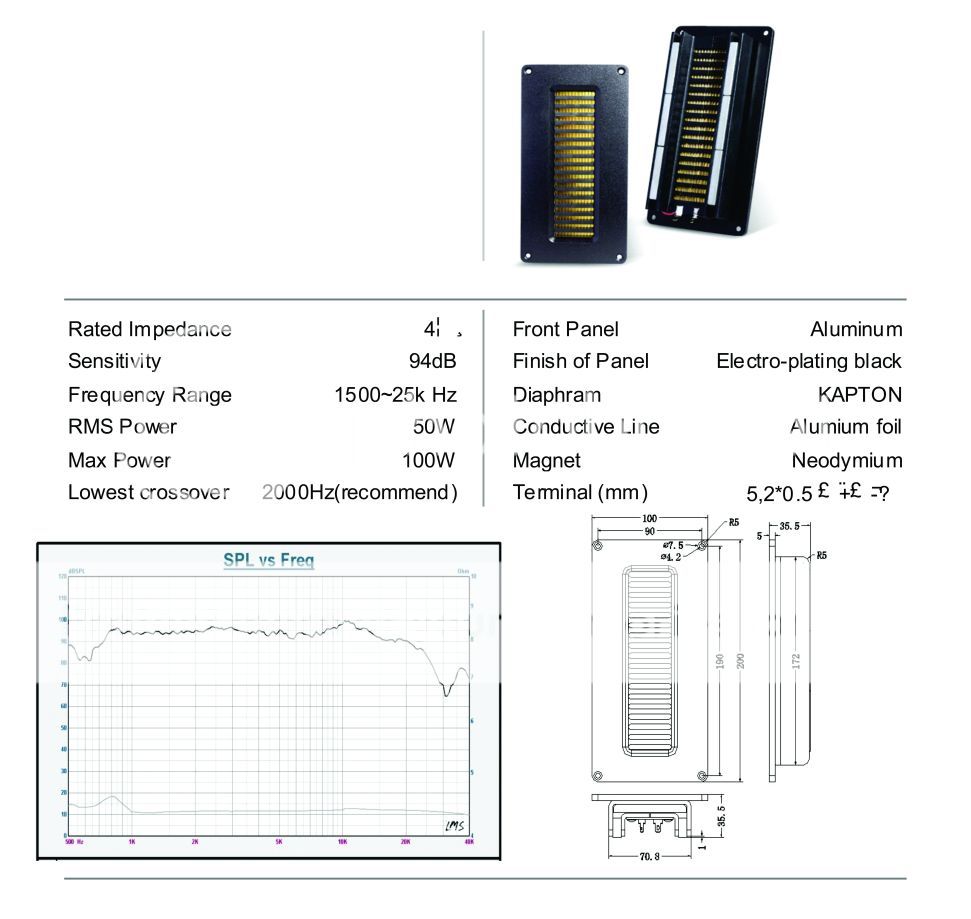
i made two drawings :
Boths MTMW design, the amt back open, woofer bass reflex, eventually active with a plate amp. Crossover 100hz, and 1,8khz. Fully time aligned to the listeners position at 4m distance.
1.
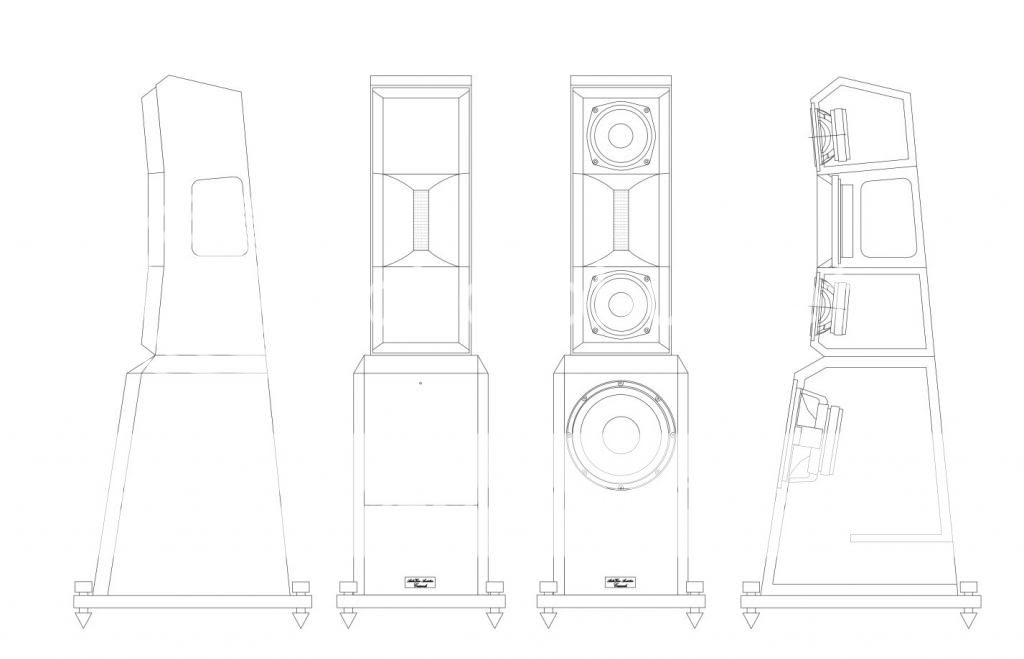
Here i would use the chinese amt, a pair either of
Beyma 6" :
6P200Fe
http://profesional.beyma.com/pdf/6P200FeE.pdf
or 6G40Fe
http://profesional.beyma.com/pdf/6G40FeE.pdf
and woofer :
either :10G40
http://profesional.beyma.com/pdf/10G40E.pdf
or 10LW30NE
http://profesional.beyma.com/pdf/http://profesional.beyma.com/pdf/10LW30NE.pdfE.pdf
and a second design in a smaller package :
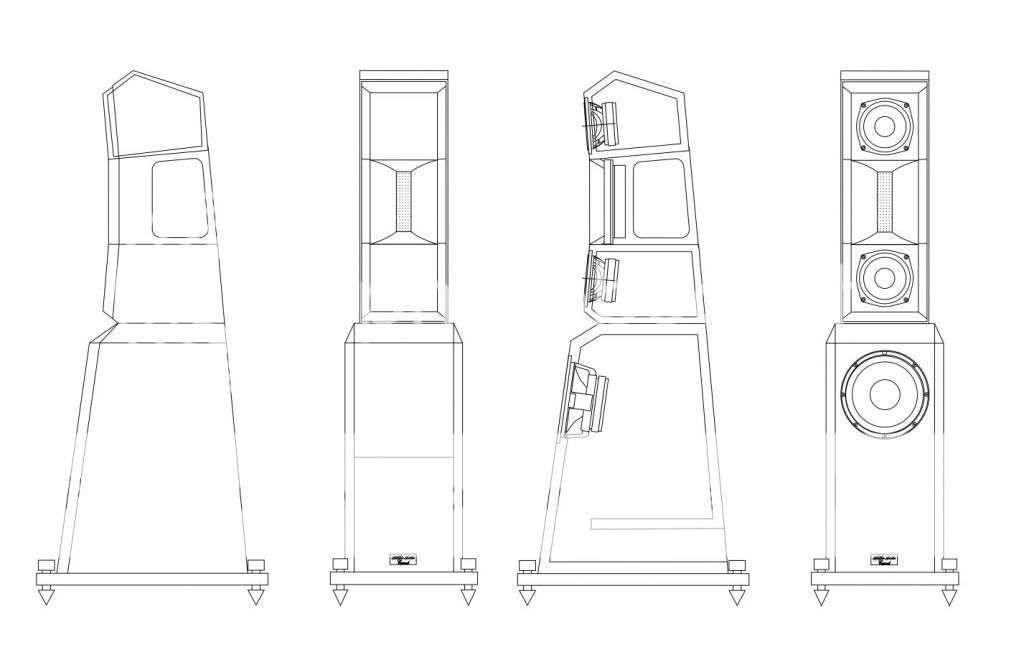
here the choice of mids and woofers would be easyer :
for the mids :5P200Fe
http://profesional.beyma.com/pdf/5P200FeE.pdf
and woofer : 8P300Fe
http://profesional.beyma.com/pdf/http://profesional.beyma.com/pdf/8P300FeE.pdfE.pdf
comments ?
So : two weeks ago i attended a High-end Audio Show in São Paulo. Spoke to some expositors, showed my designs, and they liked them very much. So i am encouraged maibe to make something commercial. Most of the exposed speakers were rather small size, to fit small living rooms.
So i am designing a speaker system, which should attend following criteria :
be small, not too expensive, but still with excellent sonic performance, and nice lookings.
The Beyma TPL is expensive. I found following alternative :
AMT : YDG718-01-4Ω-50W

i made two drawings :
Boths MTMW design, the amt back open, woofer bass reflex, eventually active with a plate amp. Crossover 100hz, and 1,8khz. Fully time aligned to the listeners position at 4m distance.
1.

Here i would use the chinese amt, a pair either of
Beyma 6" :
6P200Fe
http://profesional.beyma.com/pdf/6P200FeE.pdf
or 6G40Fe
http://profesional.beyma.com/pdf/6G40FeE.pdf
and woofer :
either :10G40
http://profesional.beyma.com/pdf/10G40E.pdf
or 10LW30NE
http://profesional.beyma.com/pdf/http://profesional.beyma.com/pdf/10LW30NE.pdfE.pdf
and a second design in a smaller package :

here the choice of mids and woofers would be easyer :
for the mids :5P200Fe
http://profesional.beyma.com/pdf/5P200FeE.pdf
and woofer : 8P300Fe
http://profesional.beyma.com/pdf/http://profesional.beyma.com/pdf/8P300FeE.pdfE.pdf
comments ?
Last edited:
Minimum cross-over is 2000 hz for that tweeter, which usually means 2000hz is too low. Companies tend to stretch the range of drivers. I would cross higher to a different mid. Like the Audax PR17MO. 2 of em in open baffle coupled to a dipole amt at 3000 gives you a high sensitivity midrange-high setup ready for "class a" power. Don;t try to cross it at 100 hz tho. Go for 250.
pro audio woofers simply don;t go low enough in small enclosures.
since you go active on the woofers, i wouldn;t worry as much for sensitivity.
For a cheap high quality woofer, i suggest dayton rs-270.
Please tell us more about your goals for these speakers.
How much spl?
Passive/active/ maybe even dsp? or just active on woofers?
How important is sensitivity
Open baffle or not (i remember you like open baffle)
etc
I think you can;t replicate the beyma amt capabilities by replacing it with a cheaper amt tweeter.
You sort off can by using a compression driver but with different sound.
Or by the B&G neo3, but with lower sensitivity and lower max spl. can be dipole as well. Is cheap too.
You can use cheap amt with semi-descent sensivitity, but you need to cross higher, and distortion wouln;t be good.
pro audio woofers simply don;t go low enough in small enclosures.
since you go active on the woofers, i wouldn;t worry as much for sensitivity.
For a cheap high quality woofer, i suggest dayton rs-270.
Please tell us more about your goals for these speakers.
How much spl?
Passive/active/ maybe even dsp? or just active on woofers?
How important is sensitivity
Open baffle or not (i remember you like open baffle)
etc
I think you can;t replicate the beyma amt capabilities by replacing it with a cheaper amt tweeter.
You sort off can by using a compression driver but with different sound.
Or by the B&G neo3, but with lower sensitivity and lower max spl. can be dipole as well. Is cheap too.
You can use cheap amt with semi-descent sensivitity, but you need to cross higher, and distortion wouln;t be good.
Minimum cross-over is 2000 hz for that tweeter, which usually means 2000hz is too low. Companies tend to stretch the range of drivers. I would cross higher to a different mid. Like the Audax PR17MO. 2 of em in open baffle coupled to a dipole amt at 3000 gives you a high sensitivity midrange-high setup ready for "class a" power. Don;t try to cross it at 100 hz tho. Go for 250.
I appreciate your input - using the Audax would be a interesting approach : can it be crossed that low , used in open baffle ?
One of the main reasons i like the amt so much is its effortless and very natural mid-range. I simply do not know yet a cone mid-range, that has the abilities of reproduce specially voices so natural. The higher you cross it, the less you take advantage of these qualities.
pro audio woofers simply don;t go low enough in small enclosures.
since you go active on the woofers, i wouldn;t worry as much for sensitivity.
For a cheap high quality woofer, i suggest dayton rs-270.
One of my concerns is indeed how to get " fast " and tight bass without boom, but still with good low extension. That does not mean, that it should not sound soft as well ( i can't imagine low bass in another way ). A good compromise between. There seem to be interesting solutions, like the Focal Daline Transmission line. But these require tall cabinets. Mai be there are other ways to make pro woofers having more low extension. Like equalizing with sub plate amps, don't know if that is the best route to go.
Please tell us more about your goals for these speakers.
How much spl?
They should have enough headroom the be able to play with low distortion at high volume in normal living room conditions. Efficiency of 92 - 95db/2,83V, preferably not less.
Passive/active/ maybe even dsp? or just active on woofers?
If i could manage to find woofers with high efficiency, to match the mid/treble, but still good low extenstion, to ~30 -35hz, than a sub plate amp would not be necessary.
How important is sensitivity
Open baffle or not (i remember you like open baffle)
etc
I do not like bass in open baffle. Not heard yet one that sounds as a costumed to. Heard Jamo open baffle recently, and not liked it. That might not be my last word, but so far, i would prefere bass reflex, or horn, or transmission line, whatever. the small horn sub from Cowan audio goes theoretically flat down to 40hz, in a small package.
William Cowan's Homepage
Looks attractive to me, maibe someone has experience with it. Since i have a similar horn sub bigger size, i know this topology sounds, and i like it :
I think you can;t replicate the beyma amt capabilities by replacing it with a cheaper amt tweeter.
Only try out will tell the story. The chinese amt has less efficiency ( they use less neo magnets to keep price down ), but may be that it sounds as good as, or comes close.
You sort off can by using a compression driver but with different sound.
That is a no-no. A amt would be a must, even if i had in the end to use the TPL, at a higher price.
You can use cheap amt with semi-descent sensivitity, but you need to cross higher, and distortion wouln;t be good.
I will test the chinese amt, to know......
correction Cowan 210 horn sub
Aloha Angelo.
I just build those Cowan 210 horn sub Junior. It is the best sounding solution that I have build including scoops, TH, BP, PPSL, Cubo etc. But it dos's NOT go to 40hz. It works perfect in 55-160hz range. Unbelievable good. Fast and touching with excellent tone. But for 40hz you have to build 4 and put them in a corner.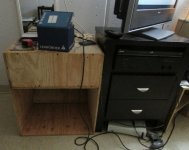
I appreciate your input - using the Audax would be a interesting approach : can it be crossed that low , used in open baffle ?
One of the main reasons i like the amt so much is its effortless and very natural mid-range. I simply do not know yet a cone mid-range, that has the abilities of reproduce specially voices so natural. The higher you cross it, the less you take advantage of these qualities.
One of my concerns is indeed how to get " fast " and tight bass without boom, but still with good low extension. That does not mean, that it should not sound soft as well ( i can't imagine low bass in another way ). A good compromise between. There seem to be interesting solutions, like the Focal Daline Transmission line. But these require tall cabinets. Mai be there are other ways to make pro woofers having more low extension. Like equalizing with sub plate amps, don't know if that is the best route to go.
They should have enough headroom the be able to play with low distortion at high volume in normal living room conditions. Efficiency of 92 - 95db/2,83V, preferably not less.
If i could manage to find woofers with high efficiency, to match the mid/treble, but still good low extenstion, to ~30 -35hz, than a sub plate amp would not be necessary.
I do not like bass in open baffle. Not heard yet one that sounds as a costumed to. Heard Jamo open baffle recently, and not liked it. That might not be my last word, but so far, i would prefere bass reflex, or horn, or transmission line, whatever. the small horn sub from Cowan audio goes theoretically flat down to 40hz, in a small package.
William Cowan's Homepage
Looks attractive to me, maibe someone has experience with it. Since i have a similar horn sub bigger size, i know this topology sounds, and i like it :
Only try out will tell the story. The chinese amt has less efficiency ( they use less neo magnets to keep price down ), but may be that it sounds as good as, or comes close.
That is a no-no. A amt would be a must, even if i had in the end to use the TPL, at a higher price.
I will test the chinese amt, to know......
Aloha Angelo.
I just build those Cowan 210 horn sub Junior. It is the best sounding solution that I have build including scoops, TH, BP, PPSL, Cubo etc. But it dos's NOT go to 40hz. It works perfect in 55-160hz range. Unbelievable good. Fast and touching with excellent tone. But for 40hz you have to build 4 and put them in a corner.

Aloha Angelo.
I just build those Cowan 210 horn sub Junior. It is the best sounding solution that I have build including scoops, TH, BP, PPSL, Cubo etc. But it dos's NOT go to 40hz. It works perfect in 55-160hz range. Unbelievable good. Fast and touching with excellent tone. But for 40hz you have to build 4 and put them in a corner. View attachment 374215
hi Sergey
can you show a cross section drawing to see how the horn is folded, and dimensions ?
Listening to a wide variety of music through my system in the last few days, after i got amplification finally right. Its a lot of fun.
Saw a comment on the 12p80nd:
HiFiForum.nu - Beyma TPL-150H together with what I ...?
I would say 12P80Nd (note not "Fe"!).
They are wonderfully efficient and ultra dynamic elements. I've never heard anything like in the case of transients and "cut" in the sound.
Nd magnets have a much larger magnetic stability, and when it comes 12P80Nd so is their pole pieces very well saturated and very stable and resistant to eddy-currents on the stuff.
Due to its ultra-strong magnetic system will answer them very nicely on the current drive, which probably can get them than some djeafligare regard impulse response and dynamics.
They also sounds very neutral (for being so efficient) and regular.
They are unique elements simply.
I could not agree more. This combo, TPL/12p80nd amazes me with its clean, dynamic and natural sound, as nothing else i heard beside.
Last edited:
PHL has excellent high sensitivity drivers that are a nice match for the Beyma AMT TPL150H.
Here are some designs: lsv-achenbach
Here are some designs: lsv-achenbach
PHL has excellent high sensitivity drivers that are a nice match for the Beyma AMT TPL150H.
Here are some designs: lsv-achenbach
I contacted PHL Audio about six month ago. They were not very responsive. Taking many days to respond emails.....
I contacted PHL Audio about six month ago. They were not very responsive. Taking many days to respond emails.....
You're better off with contacting la maison du haut-parleur for PHL, Audax or other drivers.
Next Year i want to realise the project i presented at post No.130. I am still figuring out which midrange and woofers to use. Yesterday i had some audio-friends visiting me. They recommended me to use what i am familiar with, regardless of prize, and to make the best sounding speaker as possible, and send it to a local audio magazine for review, to draw attention. I think that's a good suggestion. So the chinese amt is discarded for now, i will use the TPL150. The Beyma 5P200Fe has the advantage of having considerable low frequency extension, so the MTM module could be used a bookshelf. I am however unsure if midrange is up with the best dedicated midrange speakers out there. Two alternatives i am considering is the PHL 1120, or B & C 6NDL38. The PHL is having excellent reviews, but frequency response graphs show, that above 1khz it needs to be smoothed out.
Midrange test data 2
The B & C looks better.
BC 6NDL38 Photos by augerpro | Photobucket
Any other suggestions ?
Midrange test data 2
The B & C looks better.
BC 6NDL38 Photos by augerpro | Photobucket
Any other suggestions ?
Maybe my first choice at the moment is the 15P80Nd crossed at 1,1kHz (passive). It sounds great and has amazing dynamics and super clear midrange. I hope that I can try the new 15P80Fe soon, as it looks a bit better than the 15P80Nd on paper.
Could you clarify what you mean by that?
?? Has anyone built a 60 x 40 horn/wavegide for the Beyma TPL-150 with 1600Hz Xover ?? (PK??)
WE HAD A DREAM... that the TPL-150H could be crossed at 1,200Hz with low distortion and HEAVENLY 99db/w dynamics, plus controlled directivity up to 20khz so it could be seamlessly mated to a high efficiency 10" or 12" midbass for a >96 db/w watt speaker.
BUT... There is a difference between covering a frequency range with flat frequency response, and sounding beautiful while doing so.
The group brain trust said .. NO .. not 1,200Hz ... high distortion data when 1,200Hz tone is combined with 10Khz+ tone.
The group brain trust said ... not 1,400Hz ... the TPL-150H sounds strained.
The group brain trust said ... OK if >1600Hz, and the TPL-150 driver benefits from removing the rear chamber and felt damping pad, and allowing the rear exit into a large damped chamber. THD is reduced by almost 20 dB by doing this.
Two common ~1600hz Xover combinations:
1) standard 80x40 horn with an 8" midbass, add a 15" woofer. Avoids MTM lobing. Sd of 6" midrange ~0.013m^2. Sd of 8" ~ 0.022m^2
2) NEW 60x40 horn/waveguide with a 12" midbass Xover 1600Hz, add a 18" woofer. The controlled directivity function narrows at a low'ish frequency to gain efficiency of large midbass.
WE HAD A DREAM... that the TPL-150H could be crossed at 1,200Hz with low distortion and HEAVENLY 99db/w dynamics, plus controlled directivity up to 20khz so it could be seamlessly mated to a high efficiency 10" or 12" midbass for a >96 db/w watt speaker.
BUT... There is a difference between covering a frequency range with flat frequency response, and sounding beautiful while doing so.
The group brain trust said .. NO .. not 1,200Hz ... high distortion data when 1,200Hz tone is combined with 10Khz+ tone.
The group brain trust said ... not 1,400Hz ... the TPL-150H sounds strained.
The group brain trust said ... OK if >1600Hz, and the TPL-150 driver benefits from removing the rear chamber and felt damping pad, and allowing the rear exit into a large damped chamber. THD is reduced by almost 20 dB by doing this.
Two common ~1600hz Xover combinations:
1) standard 80x40 horn with an 8" midbass, add a 15" woofer. Avoids MTM lobing. Sd of 6" midrange ~0.013m^2. Sd of 8" ~ 0.022m^2
2) NEW 60x40 horn/waveguide with a 12" midbass Xover 1600Hz, add a 18" woofer. The controlled directivity function narrows at a low'ish frequency to gain efficiency of large midbass.
- Home
- Loudspeakers
- Multi-Way
- Best midrange to pair with Beyma TPL-150

